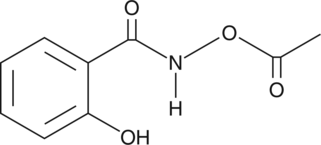Cayman
Showing 32851–33000 of 45550 results
-
Abnormal cannabidiol is a synthetic regioisomer of cannabidiol that fails to elicit either central cannabinoid (CB1) or peripheral cannabinoid (CB2) receptors responsiveness and is without psychotropic activity. It induces endothelium-dependent vasodilation via a CB1/CB2/nitric oxide-independent mechanism.{11092} O-1821 is a cannabidiol analog with close structural similarity to O-1918 which is a selective antagonist of abnormal cannabidiol at the non-central cannabinoid (CB1)/peripheral cannabinoid (CB2) receptors endothelial receptor.{11761} O-1918 does not bind to CB1 or CB2 receptors at concentrations up to 30 µM and inhibits the vasorelaxant effects of abnormal cannabidiol in vitro and in whole animals.{11761} The biological activity of O-1821 has not been reported.
Brand:CaymanSKU:10006804 - 10 mgAvailable on backorder
Abnormal cannabidiol is a synthetic regioisomer of cannabidiol that fails to elicit either central cannabinoid (CB1) or peripheral cannabinoid (CB2) receptors responsiveness and is without psychotropic activity. It induces endothelium-dependent vasodilation via a CB1/CB2/nitric oxide-independent mechanism.{11092} O-1821 is a cannabidiol analog with close structural similarity to O-1918 which is a selective antagonist of abnormal cannabidiol at the non-central cannabinoid (CB1)/peripheral cannabinoid (CB2) receptors endothelial receptor.{11761} O-1918 does not bind to CB1 or CB2 receptors at concentrations up to 30 µM and inhibits the vasorelaxant effects of abnormal cannabidiol in vitro and in whole animals.{11761} The biological activity of O-1821 has not been reported.
Brand:CaymanSKU:10006804 - 5 mgAvailable on backorder
Abnormal cannabidiol is a synthetic regioisomer of cannabidiol that fails to elicit either central cannabinoid (CB1) or peripheral cannabinoid (CB2) receptors responsiveness and is without psychotropic activity. It induces endothelium-dependent vasodilation via a CB1/CB2/nitric oxide-independent mechanism.{11092} O-1821 is a cannabidiol analog with close structural similarity to O-1918 which is a selective antagonist of abnormal cannabidiol at the non-central cannabinoid (CB1)/peripheral cannabinoid (CB2) receptors endothelial receptor.{11761} O-1918 does not bind to CB1 or CB2 receptors at concentrations up to 30 µM and inhibits the vasorelaxant effects of abnormal cannabidiol in vitro and in whole animals.{11761} The biological activity of O-1821 has not been reported.
Brand:CaymanSKU:10006804 - 50 mgAvailable on backorder
Abnormal cannabidiol is a synthetic regioisomer of cannabidiol that fails to elicit either central cannabinoid (CB1) or peripheral cannabinoid (CB2) responsiveness and is without psychotropic activity. It induces endothelium-dependent vasodilation via a CB1/CB2/nitric oxide-independent mechanism. O-1918 is a cannabidiol analog that acts as a selective antagonist of abnormal cannabidiol at the non-CB1/CB2 endothelial receptor. It does not bind to CB1 or CB2 receptors at concentrations up to 30 µM and inhibits the vasorelaxant effects of abnormal cannabidiol in vitro and in whole animals.{11761} It also blocks the abnormal cannabidiol-induced activation of the phosphatidylinositol 3-kinase/Akt pathway in human umbilical vein endothelial cells.{11761}
Brand:CaymanSKU:10004914 - 1 mgAvailable on backorder
Abnormal cannabidiol is a synthetic regioisomer of cannabidiol that fails to elicit either central cannabinoid (CB1) or peripheral cannabinoid (CB2) responsiveness and is without psychotropic activity. It induces endothelium-dependent vasodilation via a CB1/CB2/nitric oxide-independent mechanism. O-1918 is a cannabidiol analog that acts as a selective antagonist of abnormal cannabidiol at the non-CB1/CB2 endothelial receptor. It does not bind to CB1 or CB2 receptors at concentrations up to 30 µM and inhibits the vasorelaxant effects of abnormal cannabidiol in vitro and in whole animals.{11761} It also blocks the abnormal cannabidiol-induced activation of the phosphatidylinositol 3-kinase/Akt pathway in human umbilical vein endothelial cells.{11761}
Brand:CaymanSKU:10004914 - 10 mgAvailable on backorder
Abnormal cannabidiol is a synthetic regioisomer of cannabidiol that fails to elicit either central cannabinoid (CB1) or peripheral cannabinoid (CB2) responsiveness and is without psychotropic activity. It induces endothelium-dependent vasodilation via a CB1/CB2/nitric oxide-independent mechanism. O-1918 is a cannabidiol analog that acts as a selective antagonist of abnormal cannabidiol at the non-CB1/CB2 endothelial receptor. It does not bind to CB1 or CB2 receptors at concentrations up to 30 µM and inhibits the vasorelaxant effects of abnormal cannabidiol in vitro and in whole animals.{11761} It also blocks the abnormal cannabidiol-induced activation of the phosphatidylinositol 3-kinase/Akt pathway in human umbilical vein endothelial cells.{11761}
Brand:CaymanSKU:10004914 - 25 mgAvailable on backorder
Abnormal cannabidiol is a synthetic regioisomer of cannabidiol that fails to elicit either central cannabinoid (CB1) or peripheral cannabinoid (CB2) responsiveness and is without psychotropic activity. It induces endothelium-dependent vasodilation via a CB1/CB2/nitric oxide-independent mechanism. O-1918 is a cannabidiol analog that acts as a selective antagonist of abnormal cannabidiol at the non-CB1/CB2 endothelial receptor. It does not bind to CB1 or CB2 receptors at concentrations up to 30 µM and inhibits the vasorelaxant effects of abnormal cannabidiol in vitro and in whole animals.{11761} It also blocks the abnormal cannabidiol-induced activation of the phosphatidylinositol 3-kinase/Akt pathway in human umbilical vein endothelial cells.{11761}
Brand:CaymanSKU:10004914 - 5 mgAvailable on backorder
Cannabinoid agonists are typically highly lipophilic compounds that require solubilization with either a surfactant agent or adherence to a water miscible substance such as albumin, Tween 80, or Emulphor. O-2545 is a potent water-soluble agonist of central cannabinoid (CB1) and peripheral cannabinoid (CB2) receptors with Ki values of 1.5 and 0.32 nM, respectively.{14718} When dissolved in saline, O-2545 was highly efficacious in mouse behavioral models when administered either intravenously or intracerebroventricularly.{14718}
Brand:CaymanSKU:10009195 - 1 mgAvailable on backorder
Cannabinoid agonists are typically highly lipophilic compounds that require solubilization with either a surfactant agent or adherence to a water miscible substance such as albumin, Tween 80, or Emulphor. O-2545 is a potent water-soluble agonist of central cannabinoid (CB1) and peripheral cannabinoid (CB2) receptors with Ki values of 1.5 and 0.32 nM, respectively.{14718} When dissolved in saline, O-2545 was highly efficacious in mouse behavioral models when administered either intravenously or intracerebroventricularly.{14718}
Brand:CaymanSKU:10009195 - 10 mgAvailable on backorder
Cannabinoid agonists are typically highly lipophilic compounds that require solubilization with either a surfactant agent or adherence to a water miscible substance such as albumin, Tween 80, or Emulphor. O-2545 is a potent water-soluble agonist of central cannabinoid (CB1) and peripheral cannabinoid (CB2) receptors with Ki values of 1.5 and 0.32 nM, respectively.{14718} When dissolved in saline, O-2545 was highly efficacious in mouse behavioral models when administered either intravenously or intracerebroventricularly.{14718}
Brand:CaymanSKU:10009195 - 5 mgAvailable on backorder
Cannabinoid agonists are typically highly lipophilic compounds that require solubilization with either a surfactant agent or adherence to a water miscible substance such as albumin, Tween 80, or Emulphor. O-2545 is a potent water-soluble agonist of central cannabinoid (CB1) and peripheral cannabinoid (CB2) receptors with Ki values of 1.5 and 0.32 nM, respectively.{14718} When dissolved in saline, O-2545 was highly efficacious in mouse behavioral models when administered either intravenously or intracerebroventricularly.{14718}
Brand:CaymanSKU:10009195 - 500 µgAvailable on backorder
O-304 is a pan-activator of AMP-activated protein kinase (AMPK).{48264} It increases levels of phosphorylated AMPK (pAMPK) without reducing cellular ATP. O-304 suppresses dephosphorylation of AMPKα, AMPKβ, and AMPKγ trimers at threonine 172 (T172) mediated by protein phosphatase 2C (PP2C) without inhibiting PP2C activity in Wi-38 lung fibroblasts. In vivo, O-304 (100 mg/kg) prevents high-fat diet-induced increases in fasted glucose and plasma insulin levels and development of insulin resistance, as well as increases calf muscle pAMPK levels in mice.
Brand:CaymanSKU:26186 - 1 mgAvailable on backorder
O-304 is a pan-activator of AMP-activated protein kinase (AMPK).{48264} It increases levels of phosphorylated AMPK (pAMPK) without reducing cellular ATP. O-304 suppresses dephosphorylation of AMPKα, AMPKβ, and AMPKγ trimers at threonine 172 (T172) mediated by protein phosphatase 2C (PP2C) without inhibiting PP2C activity in Wi-38 lung fibroblasts. In vivo, O-304 (100 mg/kg) prevents high-fat diet-induced increases in fasted glucose and plasma insulin levels and development of insulin resistance, as well as increases calf muscle pAMPK levels in mice.
Brand:CaymanSKU:26186 - 10 mgAvailable on backorder
O-304 is a pan-activator of AMP-activated protein kinase (AMPK).{48264} It increases levels of phosphorylated AMPK (pAMPK) without reducing cellular ATP. O-304 suppresses dephosphorylation of AMPKα, AMPKβ, and AMPKγ trimers at threonine 172 (T172) mediated by protein phosphatase 2C (PP2C) without inhibiting PP2C activity in Wi-38 lung fibroblasts. In vivo, O-304 (100 mg/kg) prevents high-fat diet-induced increases in fasted glucose and plasma insulin levels and development of insulin resistance, as well as increases calf muscle pAMPK levels in mice.
Brand:CaymanSKU:26186 - 5 mgAvailable on backorder
m-3M3FBS (Item No. 16867) is an activator of phospholipase C (PLC) that stimulates superoxide generation, cytoplasmic calcium increase, and inositol phosphate formation in humans.{27909} It is used to study PLC signaling in cells and animals, often in conjunction with the PLC inhibitor U-73122 (Item No. 70740).{27905,27907,27908} o-3M3FBS is an inactive analog of m-3M3FBS that can be used as a negative control.{27909}
Brand:CaymanSKU:-Out of stock
m-3M3FBS (Item No. 16867) is an activator of phospholipase C (PLC) that stimulates superoxide generation, cytoplasmic calcium increase, and inositol phosphate formation in humans.{27909} It is used to study PLC signaling in cells and animals, often in conjunction with the PLC inhibitor U-73122 (Item No. 70740).{27905,27907,27908} o-3M3FBS is an inactive analog of m-3M3FBS that can be used as a negative control.{27909}
Brand:CaymanSKU:-Out of stock
m-3M3FBS (Item No. 16867) is an activator of phospholipase C (PLC) that stimulates superoxide generation, cytoplasmic calcium increase, and inositol phosphate formation in humans.{27909} It is used to study PLC signaling in cells and animals, often in conjunction with the PLC inhibitor U-73122 (Item No. 70740).{27905,27907,27908} o-3M3FBS is an inactive analog of m-3M3FBS that can be used as a negative control.{27909}
Brand:CaymanSKU:-Out of stock
m-3M3FBS (Item No. 16867) is an activator of phospholipase C (PLC) that stimulates superoxide generation, cytoplasmic calcium increase, and inositol phosphate formation in humans.{27909} It is used to study PLC signaling in cells and animals, often in conjunction with the PLC inhibitor U-73122 (Item No. 70740).{27905,27907,27908} o-3M3FBS is an inactive analog of m-3M3FBS that can be used as a negative control.{27909}
Brand:CaymanSKU:-Out of stock
In humans, two forms of diacylglycerol lipase, DAGLα and DAGLβ, generate the endocannabinoid 2-arachidonoyl glycerol (2-AG; Item No. 62160) by attacking DAG at the sn-1 position. O-7460 is a selective inhibitor of 2-AG biosynthesis via DAGLα (IC50 = 690 nM).{21752} It demonstrates much weaker inhibition towards human monoacylglycerol lipase and rat brain fatty acid amide hydrolase (IC50s > 10 µM) and does not bind to CB1 or CB2 cannabinoid receptors (Kis > 10 µM).{21752} At 0-12 mg/kg, i.p. in mice, O-7460 was reported to dose-dependently inhibit high-fat diet intake and reduce body weight.{21752}
Brand:CaymanSKU:-In humans, two forms of diacylglycerol lipase, DAGLα and DAGLβ, generate the endocannabinoid 2-arachidonoyl glycerol (2-AG; Item No. 62160) by attacking DAG at the sn-1 position. O-7460 is a selective inhibitor of 2-AG biosynthesis via DAGLα (IC50 = 690 nM).{21752} It demonstrates much weaker inhibition towards human monoacylglycerol lipase and rat brain fatty acid amide hydrolase (IC50s > 10 µM) and does not bind to CB1 or CB2 cannabinoid receptors (Kis > 10 µM).{21752} At 0-12 mg/kg, i.p. in mice, O-7460 was reported to dose-dependently inhibit high-fat diet intake and reduce body weight.{21752}
Brand:CaymanSKU:-In humans, two forms of diacylglycerol lipase, DAGLα and DAGLβ, generate the endocannabinoid 2-arachidonoyl glycerol (2-AG; Item No. 62160) by attacking DAG at the sn-1 position. O-7460 is a selective inhibitor of 2-AG biosynthesis via DAGLα (IC50 = 690 nM).{21752} It demonstrates much weaker inhibition towards human monoacylglycerol lipase and rat brain fatty acid amide hydrolase (IC50s > 10 µM) and does not bind to CB1 or CB2 cannabinoid receptors (Kis > 10 µM).{21752} At 0-12 mg/kg, i.p. in mice, O-7460 was reported to dose-dependently inhibit high-fat diet intake and reduce body weight.{21752}
Brand:CaymanSKU:-O-Acetyl Salicylhydroxamic Acid (O-ASHA) is an irreversible, non-selective inhibitor of COX-1 and COX-2. Aspirin is the best-studied example of an irreversible COX inhibitor, acting via the acetylation of the active site serine residue 529 in human COX-1. O-ASHA inhibits ovine COX-1 in a time-dependent, irreversible manner with a 50% B/B0 value of approximately 4.5 mM.{9607}
Brand:CaymanSKU:70263 - 1 mgAvailable on backorder
O-Acetyl Salicylhydroxamic Acid (O-ASHA) is an irreversible, non-selective inhibitor of COX-1 and COX-2. Aspirin is the best-studied example of an irreversible COX inhibitor, acting via the acetylation of the active site serine residue 529 in human COX-1. O-ASHA inhibits ovine COX-1 in a time-dependent, irreversible manner with a 50% B/B0 value of approximately 4.5 mM.{9607}
Brand:CaymanSKU:70263 - 10 mgAvailable on backorder
O-Acetyl Salicylhydroxamic Acid (O-ASHA) is an irreversible, non-selective inhibitor of COX-1 and COX-2. Aspirin is the best-studied example of an irreversible COX inhibitor, acting via the acetylation of the active site serine residue 529 in human COX-1. O-ASHA inhibits ovine COX-1 in a time-dependent, irreversible manner with a 50% B/B0 value of approximately 4.5 mM.{9607}
Brand:CaymanSKU:70263 - 5 mgAvailable on backorder
O-Acetyl Salicylhydroxamic Acid (O-ASHA) is an irreversible, non-selective inhibitor of COX-1 and COX-2. Aspirin is the best-studied example of an irreversible COX inhibitor, acting via the acetylation of the active site serine residue 529 in human COX-1. O-ASHA inhibits ovine COX-1 in a time-dependent, irreversible manner with a 50% B/B0 value of approximately 4.5 mM.{9607}
Brand:CaymanSKU:70263 - 50 mgAvailable on backorder
Arachidonoyl ethanolamide (AEA) was the first endogenous cannabinoid to be isolated and characterized as an agonist acting on the same receptors (CB1 and CB2) as tetrahydrocannabinols (THC).{1134,2713} Since that time, a number of related endocannabinoids have been isolated, most notably 2-arachidonoyl glycerol (2-AG).{5306} O-Arachidonoyl ethanolamine hydrochloride (O-AEA) is a recently isolated constituent of human and rat brain wherein the ethanolamine moiety is attached “backwards”, as an ester instead of an amide, as in AEA.{1134,2713,9804} O-AEA has mixed agonist/antagonist activity at the CB1 receptor and does not appear to be the native endogenous cannabinoid agonist at this receptor. This is in keeping with other observations that 2-AG is the primary endogenous CB1 receptor ligand.{7182}
Brand:CaymanSKU:91050 - 1 mgAvailable on backorder
Arachidonoyl ethanolamide (AEA) was the first endogenous cannabinoid to be isolated and characterized as an agonist acting on the same receptors (CB1 and CB2) as tetrahydrocannabinols (THC).{1134,2713} Since that time, a number of related endocannabinoids have been isolated, most notably 2-arachidonoyl glycerol (2-AG).{5306} O-Arachidonoyl ethanolamine hydrochloride (O-AEA) is a recently isolated constituent of human and rat brain wherein the ethanolamine moiety is attached “backwards”, as an ester instead of an amide, as in AEA.{1134,2713,9804} O-AEA has mixed agonist/antagonist activity at the CB1 receptor and does not appear to be the native endogenous cannabinoid agonist at this receptor. This is in keeping with other observations that 2-AG is the primary endogenous CB1 receptor ligand.{7182}
Brand:CaymanSKU:91050 - 10 mgAvailable on backorder
Arachidonoyl ethanolamide (AEA) was the first endogenous cannabinoid to be isolated and characterized as an agonist acting on the same receptors (CB1 and CB2) as tetrahydrocannabinols (THC).{1134,2713} Since that time, a number of related endocannabinoids have been isolated, most notably 2-arachidonoyl glycerol (2-AG).{5306} O-Arachidonoyl ethanolamine hydrochloride (O-AEA) is a recently isolated constituent of human and rat brain wherein the ethanolamine moiety is attached “backwards”, as an ester instead of an amide, as in AEA.{1134,2713,9804} O-AEA has mixed agonist/antagonist activity at the CB1 receptor and does not appear to be the native endogenous cannabinoid agonist at this receptor. This is in keeping with other observations that 2-AG is the primary endogenous CB1 receptor ligand.{7182}
Brand:CaymanSKU:91050 - 25 mgAvailable on backorder
Arachidonoyl ethanolamide (AEA) was the first endogenous cannabinoid to be isolated and characterized as an agonist acting on the same receptors (CB1 and CB2) as tetrahydrocannabinols (THC).{1134,2713} Since that time, a number of related endocannabinoids have been isolated, most notably 2-arachidonoyl glycerol (2-AG).{5306} O-Arachidonoyl ethanolamine hydrochloride (O-AEA) is a recently isolated constituent of human and rat brain wherein the ethanolamine moiety is attached “backwards”, as an ester instead of an amide, as in AEA.{1134,2713,9804} O-AEA has mixed agonist/antagonist activity at the CB1 receptor and does not appear to be the native endogenous cannabinoid agonist at this receptor. This is in keeping with other observations that 2-AG is the primary endogenous CB1 receptor ligand.{7182}
Brand:CaymanSKU:91050 - 5 mgAvailable on backorder
2-Arachidonoyl glycerol (2-AG) is an endogenous ligand that binds to both central cannabinoid (CB1) and peripheral cannabinoid (CB2) receptors and is involved in the regulation of a broad range of neurotransmitter signalling functions with implications in neurodegenerative diseases, pain, cancer, and obesity.{15051} Levels of this endocannabinoid are regulated by hydrolysis to glycerol and arachidonic acid by the enzyme monoacylglycerol lipase. O-Arachidonoyl glycidol is a 2-arachidonoyl glycerol analog that blocks 2-oleoyl glycerol hydrolysis in the cytosolic and membrane fractions of rat cerebella with IC50 values of 4.5 and 19 µM, respectively.{15051} O-Arachidonoyl glycidol inhibits fatty acid amide hydrolase-catalyzed hydrolysis of arachidonoyl ethanolamide in the membrane fraction of rat cerebella with an IC50 value of 12 µM.{15051}
Brand:CaymanSKU:10010547 - 10 mgAvailable on backorder
2-Arachidonoyl glycerol (2-AG) is an endogenous ligand that binds to both central cannabinoid (CB1) and peripheral cannabinoid (CB2) receptors and is involved in the regulation of a broad range of neurotransmitter signalling functions with implications in neurodegenerative diseases, pain, cancer, and obesity.{15051} Levels of this endocannabinoid are regulated by hydrolysis to glycerol and arachidonic acid by the enzyme monoacylglycerol lipase. O-Arachidonoyl glycidol is a 2-arachidonoyl glycerol analog that blocks 2-oleoyl glycerol hydrolysis in the cytosolic and membrane fractions of rat cerebella with IC50 values of 4.5 and 19 µM, respectively.{15051} O-Arachidonoyl glycidol inhibits fatty acid amide hydrolase-catalyzed hydrolysis of arachidonoyl ethanolamide in the membrane fraction of rat cerebella with an IC50 value of 12 µM.{15051}
Brand:CaymanSKU:10010547 - 100 mgAvailable on backorder
2-Arachidonoyl glycerol (2-AG) is an endogenous ligand that binds to both central cannabinoid (CB1) and peripheral cannabinoid (CB2) receptors and is involved in the regulation of a broad range of neurotransmitter signalling functions with implications in neurodegenerative diseases, pain, cancer, and obesity.{15051} Levels of this endocannabinoid are regulated by hydrolysis to glycerol and arachidonic acid by the enzyme monoacylglycerol lipase. O-Arachidonoyl glycidol is a 2-arachidonoyl glycerol analog that blocks 2-oleoyl glycerol hydrolysis in the cytosolic and membrane fractions of rat cerebella with IC50 values of 4.5 and 19 µM, respectively.{15051} O-Arachidonoyl glycidol inhibits fatty acid amide hydrolase-catalyzed hydrolysis of arachidonoyl ethanolamide in the membrane fraction of rat cerebella with an IC50 value of 12 µM.{15051}
Brand:CaymanSKU:10010547 - 5 mgAvailable on backorder
2-Arachidonoyl glycerol (2-AG) is an endogenous ligand that binds to both central cannabinoid (CB1) and peripheral cannabinoid (CB2) receptors and is involved in the regulation of a broad range of neurotransmitter signalling functions with implications in neurodegenerative diseases, pain, cancer, and obesity.{15051} Levels of this endocannabinoid are regulated by hydrolysis to glycerol and arachidonic acid by the enzyme monoacylglycerol lipase. O-Arachidonoyl glycidol is a 2-arachidonoyl glycerol analog that blocks 2-oleoyl glycerol hydrolysis in the cytosolic and membrane fractions of rat cerebella with IC50 values of 4.5 and 19 µM, respectively.{15051} O-Arachidonoyl glycidol inhibits fatty acid amide hydrolase-catalyzed hydrolysis of arachidonoyl ethanolamide in the membrane fraction of rat cerebella with an IC50 value of 12 µM.{15051}
Brand:CaymanSKU:10010547 - 50 mgAvailable on backorder
O-Benzylhydroxylamine is a building block.{52535,52534} It has been used in the synthesis of β-lactam inhibitor precursors and fluoroquinolone derivatives with antibiotic activity.
Brand:CaymanSKU:30528 - 1 gAvailable on backorder
O-Benzylhydroxylamine is a building block.{52535,52534} It has been used in the synthesis of β-lactam inhibitor precursors and fluoroquinolone derivatives with antibiotic activity.
Brand:CaymanSKU:30528 - 5 gAvailable on backorder
O-Desmethyl gefitinib is the major metabolite of gefitinib (Item No. 13166) in human plasma, formed by the cytochrome P450 isoform CYP2D6.{39029} It is an active metabolite that inhibits EGFR similarly to gefitinib in subcellular assays (IC50s = 36 and 22 nM, respectively) but is less active in whole cell assays (IC50s = 760 and 49 nM, respectively).{39030} In a LoVo tumor mouse xenograft model, the tumor concentration of O-desmethyl gefitinib was 6.8-fold lower than that of gefitinib and did not significantly reduce tumor growth. A high plasma concentration of O-desmethyl gefitinib in patients homozygous for CYP2D6 was not associated with an increase in adverse effects.{39028}
Brand:CaymanSKU:22365 -Out of stock
O-Desmethyl gefitinib is the major metabolite of gefitinib (Item No. 13166) in human plasma, formed by the cytochrome P450 isoform CYP2D6.{39029} It is an active metabolite that inhibits EGFR similarly to gefitinib in subcellular assays (IC50s = 36 and 22 nM, respectively) but is less active in whole cell assays (IC50s = 760 and 49 nM, respectively).{39030} In a LoVo tumor mouse xenograft model, the tumor concentration of O-desmethyl gefitinib was 6.8-fold lower than that of gefitinib and did not significantly reduce tumor growth. A high plasma concentration of O-desmethyl gefitinib in patients homozygous for CYP2D6 was not associated with an increase in adverse effects.{39028}
Brand:CaymanSKU:22365 -Out of stock
O-Desmethyl gefitinib is the major metabolite of gefitinib (Item No. 13166) in human plasma, formed by the cytochrome P450 isoform CYP2D6.{39029} It is an active metabolite that inhibits EGFR similarly to gefitinib in subcellular assays (IC50s = 36 and 22 nM, respectively) but is less active in whole cell assays (IC50s = 760 and 49 nM, respectively).{39030} In a LoVo tumor mouse xenograft model, the tumor concentration of O-desmethyl gefitinib was 6.8-fold lower than that of gefitinib and did not significantly reduce tumor growth. A high plasma concentration of O-desmethyl gefitinib in patients homozygous for CYP2D6 was not associated with an increase in adverse effects.{39028}
Brand:CaymanSKU:22365 -Out of stock
O-Desmethyl metoprolol is the major active metabolite of the β1-adrenergic receptor blocker metoprolol (Item No. 15429 | 21165).{35205} It is formed by metabolism of metoprolol by the cytochrome P450 (CYP) isoform CYP2D6 in vivo.{35202}
Brand:CaymanSKU:21787 -Out of stock
O-Desmethyl metoprolol is the major active metabolite of the β1-adrenergic receptor blocker metoprolol (Item No. 15429 | 21165).{35205} It is formed by metabolism of metoprolol by the cytochrome P450 (CYP) isoform CYP2D6 in vivo.{35202}
Brand:CaymanSKU:21787 -Out of stock
O-Desmethyl metoprolol is the major active metabolite of the β1-adrenergic receptor blocker metoprolol (Item No. 15429 | 21165).{35205} It is formed by metabolism of metoprolol by the cytochrome P450 (CYP) isoform CYP2D6 in vivo.{35202}
Brand:CaymanSKU:21787 -Out of stock
o-Dianisidine (dihydrochloride) is a colorimetric peroxidase substrate that has been used as a substrate to semi-quantitatively measure lactate, uric acid (Item No. 16219), and glucose.{14800,28302} It has also been used as a reagent for the detection of various metals, thiocyanates, and nitrites.{28303} This aromatic amine is initially colorless but turns to violet upon oxidization and is spectrophotometrically measured at a wavelength of 405 nm.
Brand:CaymanSKU:-Available on backorder
o-Dianisidine (dihydrochloride) is a colorimetric peroxidase substrate that has been used as a substrate to semi-quantitatively measure lactate, uric acid (Item No. 16219), and glucose.{14800,28302} It has also been used as a reagent for the detection of various metals, thiocyanates, and nitrites.{28303} This aromatic amine is initially colorless but turns to violet upon oxidization and is spectrophotometrically measured at a wavelength of 405 nm.
Brand:CaymanSKU:-Available on backorder
o-Dianisidine (dihydrochloride) is a colorimetric peroxidase substrate that has been used as a substrate to semi-quantitatively measure lactate, uric acid (Item No. 16219), and glucose.{14800,28302} It has also been used as a reagent for the detection of various metals, thiocyanates, and nitrites.{28303} This aromatic amine is initially colorless but turns to violet upon oxidization and is spectrophotometrically measured at a wavelength of 405 nm.
Brand:CaymanSKU:-Available on backorder
o-Dianisidine (dihydrochloride) is a colorimetric peroxidase substrate that has been used as a substrate to semi-quantitatively measure lactate, uric acid (Item No. 16219), and glucose.{14800,28302} It has also been used as a reagent for the detection of various metals, thiocyanates, and nitrites.{28303} This aromatic amine is initially colorless but turns to violet upon oxidization and is spectrophotometrically measured at a wavelength of 405 nm.
Brand:CaymanSKU:-Available on backorder
O-methyl Sterigmatocystin (OMST) is a xanthone found in several fungal species including A. flavus, A. parasiticus, A. versicolor, and B. piluliferum.{35012,35013} It is a carcinogenic precursor of aflatoxin G1 (Item No. 11295) and aflatoxin B1 (Item No. 11293) that is a known contaminant of agricultural soils.{35012,35013,35014} OMST is cytotoxic against NCI-H187 human small cell lung cancer cells and African green monkey kidney (Vero) cells (IC50s = 62.2 and 0.65 mM, respectively).{35014}
Brand:CaymanSKU:22070 -Out of stock
O-methyl Sterigmatocystin (OMST) is a xanthone found in several fungal species including A. flavus, A. parasiticus, A. versicolor, and B. piluliferum.{35012,35013} It is a carcinogenic precursor of aflatoxin G1 (Item No. 11295) and aflatoxin B1 (Item No. 11293) that is a known contaminant of agricultural soils.{35012,35013,35014} OMST is cytotoxic against NCI-H187 human small cell lung cancer cells and African green monkey kidney (Vero) cells (IC50s = 62.2 and 0.65 mM, respectively).{35014}
Brand:CaymanSKU:22070 -Out of stock
O-Methylviridicatin is a natural derivative of the alkaloid mycotoxin viridicatin, which is produced by several species of Penicillium.{31092} O-Methylviridicatin blocks activation of the HIV long terminal repeat by TNF-α in HeLa cells (IC50 = 5 µM).{31091} It also inhibits virus production in OM-10.1 cells (HL-60 promyelocytes infected with HIV-1) treated with TNF-α (IC50 = 2.5 µM).{31091}
Brand:CaymanSKU:-Available on backorder
O-Methylviridicatin is a natural derivative of the alkaloid mycotoxin viridicatin, which is produced by several species of Penicillium.{31092} O-Methylviridicatin blocks activation of the HIV long terminal repeat by TNF-α in HeLa cells (IC50 = 5 µM).{31091} It also inhibits virus production in OM-10.1 cells (HL-60 promyelocytes infected with HIV-1) treated with TNF-α (IC50 = 2.5 µM).{31091}
Brand:CaymanSKU:-Available on backorder
o-Nitrophenyl β-D-galactopyranoside (ONPG) is a chromogenic substrate for β-galactosidase.{46249,46250} Upon enzymatic cleavage by β-galactosidase, o-nitrophenol is released, which can be quantified by colorimetric detection at 420 nm as a measure of β-galactosidase activity.
Brand:CaymanSKU:26624 - 1 gAvailable on backorder
o-Nitrophenyl β-D-galactopyranoside (ONPG) is a chromogenic substrate for β-galactosidase.{46249,46250} Upon enzymatic cleavage by β-galactosidase, o-nitrophenol is released, which can be quantified by colorimetric detection at 420 nm as a measure of β-galactosidase activity.
Brand:CaymanSKU:26624 - 10 gAvailable on backorder
o-Nitrophenyl β-D-galactopyranoside (ONPG) is a chromogenic substrate for β-galactosidase.{46249,46250} Upon enzymatic cleavage by β-galactosidase, o-nitrophenol is released, which can be quantified by colorimetric detection at 420 nm as a measure of β-galactosidase activity.
Brand:CaymanSKU:26624 - 25 gAvailable on backorder
o-Nitrophenyl β-D-galactopyranoside (ONPG) is a chromogenic substrate for β-galactosidase.{46249,46250} Upon enzymatic cleavage by β-galactosidase, o-nitrophenol is released, which can be quantified by colorimetric detection at 420 nm as a measure of β-galactosidase activity.
Brand:CaymanSKU:26624 - 5 gAvailable on backorder
O-Phospho-D-serine is a phosphorylated form of D-serine, a natural amino acid made from L-serine by serine racemase in the mammalian central nervous system.{28640} It can be dephosphorylated by phosphoserine phosphatase, like its isomer O-phospho-L-serine (L-SOP; Item No. 16151).{28638} Unlike L-SOP, O-phospho-D-serine is a weak agonist of the metabotropic glutamate receptor mGluR4 (IC50 = 1,260 µM vs. 4 µM for L-SOP) and poorly blocks phosphatidylserine receptor-mediated phagocytosis.{28639,28637}
Brand:CaymanSKU:-Available on backorder
O-Phospho-D-serine is a phosphorylated form of D-serine, a natural amino acid made from L-serine by serine racemase in the mammalian central nervous system.{28640} It can be dephosphorylated by phosphoserine phosphatase, like its isomer O-phospho-L-serine (L-SOP; Item No. 16151).{28638} Unlike L-SOP, O-phospho-D-serine is a weak agonist of the metabotropic glutamate receptor mGluR4 (IC50 = 1,260 µM vs. 4 µM for L-SOP) and poorly blocks phosphatidylserine receptor-mediated phagocytosis.{28639,28637}
Brand:CaymanSKU:-Available on backorder
O-Phospho-L-Serine is an agonist of the group III metabotropic glutamate receptors mGluR4a and mGluR6 (EC50s = 2-5 µM).{26379,26380} It mimics the phosphatidylserine head group and has been shown to inhibit the proliferation of microglia and to enhance neuronal differentiation of progenitor cells.{26378,26381,26377}
Brand:CaymanSKU:-O-Phospho-L-Serine is an agonist of the group III metabotropic glutamate receptors mGluR4a and mGluR6 (EC50s = 2-5 µM).{26379,26380} It mimics the phosphatidylserine head group and has been shown to inhibit the proliferation of microglia and to enhance neuronal differentiation of progenitor cells.{26378,26381,26377}
Brand:CaymanSKU:-O-Phospho-L-Serine is an agonist of the group III metabotropic glutamate receptors mGluR4a and mGluR6 (EC50s = 2-5 µM).{26379,26380} It mimics the phosphatidylserine head group and has been shown to inhibit the proliferation of microglia and to enhance neuronal differentiation of progenitor cells.{26378,26381,26377}
Brand:CaymanSKU:-O-Phospho-L-tyrosine is a phosphorylated form of L-tyrosine. Tyrosine phosphorylation was originally discovered in proteins containing tyrosines found to be modified by tumor viruses.{41092} O-phospho-L-tyrosine is used in studies of tyrosine phosphorylation and has been used in affinity chromatography for the purification of IgG.{41093,41091,41094}
Brand:CaymanSKU:23064 - 100 mgAvailable on backorder
O-Phospho-L-tyrosine is a phosphorylated form of L-tyrosine. Tyrosine phosphorylation was originally discovered in proteins containing tyrosines found to be modified by tumor viruses.{41092} O-phospho-L-tyrosine is used in studies of tyrosine phosphorylation and has been used in affinity chromatography for the purification of IgG.{41093,41091,41094}
Brand:CaymanSKU:23064 - 250 mgAvailable on backorder
O-Phospho-L-tyrosine is a phosphorylated form of L-tyrosine. Tyrosine phosphorylation was originally discovered in proteins containing tyrosines found to be modified by tumor viruses.{41092} O-phospho-L-tyrosine is used in studies of tyrosine phosphorylation and has been used in affinity chromatography for the purification of IgG.{41093,41091,41094}
Brand:CaymanSKU:23064 - 500 mgAvailable on backorder
O-Propargyl-puromycin (OP-puro) is a clickable form of the protein synthesis inhibitor puromycin (Item No. 13884).{26288} It inhibits protein synthesis in rabbit reticulocyte lysates and HEK293T cells when used at concentrations ranging from 1 to 25 µM. OP-puro is incorporated into nascent polypeptide chains where it forms covalent adducts and terminates chain elongation on the ribosome. It has been used in combination with fluorescent azides to image nascent proteins in various cells.{26288,46902}
Brand:CaymanSKU:-O-Propargyl-puromycin (OP-puro) is a clickable form of the protein synthesis inhibitor puromycin (Item No. 13884).{26288} It inhibits protein synthesis in rabbit reticulocyte lysates and HEK293T cells when used at concentrations ranging from 1 to 25 µM. OP-puro is incorporated into nascent polypeptide chains where it forms covalent adducts and terminates chain elongation on the ribosome. It has been used in combination with fluorescent azides to image nascent proteins in various cells.{26288,46902}
Brand:CaymanSKU:-o,p’-DDE is a metabolite and degradation product of the organochlorine pesticide DDT.{39801} It accumulates in smallmouth buffalo, channel catfish, and largemouth bass as well as sediment in the Huntsville Spring Branch-Indian Creek tributary system surrounding a DDT manufacturing plant where it is considered a persistent organic pollutant (POP). o,p’-DDE inhibits estrogen binding to rainbow trout estrogen receptors (rtERs) with an IC50 value of 3.2 μM.{12991} It induces concentration-dependent secretion of estradiol by granulosa and theca cell co-cultures isolated from porcine ovarian follicles.{39802} In ovo exposure to o,p’-DDE increases degeneration of ovarian follicles and reduces testicular size in Japanese medaka (O. latipes).{39803}
Brand:CaymanSKU:24235 - 10 mgAvailable on backorder
o,p’-DDE is a metabolite and degradation product of the organochlorine pesticide DDT.{39801} It accumulates in smallmouth buffalo, channel catfish, and largemouth bass as well as sediment in the Huntsville Spring Branch-Indian Creek tributary system surrounding a DDT manufacturing plant where it is considered a persistent organic pollutant (POP). o,p’-DDE inhibits estrogen binding to rainbow trout estrogen receptors (rtERs) with an IC50 value of 3.2 μM.{12991} It induces concentration-dependent secretion of estradiol by granulosa and theca cell co-cultures isolated from porcine ovarian follicles.{39802} In ovo exposure to o,p’-DDE increases degeneration of ovarian follicles and reduces testicular size in Japanese medaka (O. latipes).{39803}
Brand:CaymanSKU:24235 - 25 mgAvailable on backorder
o,p’-DDE is a metabolite and degradation product of the organochlorine pesticide DDT.{39801} It accumulates in smallmouth buffalo, channel catfish, and largemouth bass as well as sediment in the Huntsville Spring Branch-Indian Creek tributary system surrounding a DDT manufacturing plant where it is considered a persistent organic pollutant (POP). o,p’-DDE inhibits estrogen binding to rainbow trout estrogen receptors (rtERs) with an IC50 value of 3.2 μM.{12991} It induces concentration-dependent secretion of estradiol by granulosa and theca cell co-cultures isolated from porcine ovarian follicles.{39802} In ovo exposure to o,p’-DDE increases degeneration of ovarian follicles and reduces testicular size in Japanese medaka (O. latipes).{39803}
Brand:CaymanSKU:24235 - 5 mgAvailable on backorder
o,p’-DDE is a metabolite and degradation product of the organochlorine pesticide DDT.{39801} It accumulates in smallmouth buffalo, channel catfish, and largemouth bass as well as sediment in the Huntsville Spring Branch-Indian Creek tributary system surrounding a DDT manufacturing plant where it is considered a persistent organic pollutant (POP). o,p’-DDE inhibits estrogen binding to rainbow trout estrogen receptors (rtERs) with an IC50 value of 3.2 μM.{12991} It induces concentration-dependent secretion of estradiol by granulosa and theca cell co-cultures isolated from porcine ovarian follicles.{39802} In ovo exposure to o,p’-DDE increases degeneration of ovarian follicles and reduces testicular size in Japanese medaka (O. latipes).{39803}
Brand:CaymanSKU:24235 - 50 mgAvailable on backorder
o,p’-DDT is an organochlorine pesticide that induces mortality of malaria mosquito (A. quadrimaculatus) fourth-instar larvae and A. aegypti larvae when used at concentrations ranging from 0.005 to 0.03 and 0.025 to 5 ppm, respectively.{37593,37594} It induces 100% mortality of goldfish (C. auratus) at a concentration of 4 ppm.{37594} o,p’-DDT is estrogenic, increasing oviduct weight and glycogen content of chicken and Japanese quail.{37595} It enhances mammary gland differentiation and increases epithelial cell proliferation in mammary terminal end buds in pubertal female rats.{37596} o,p’-DDT is a persistent organic pollutant (POP) and is elevated in the sera of pregnant women in malaria-endemic regions of South Africa.{37597} Formulations containing o,p’-DDT have been used to control mosquito populations and prevent the spread of malaria.
Brand:CaymanSKU:24242 - 25 mgAvailable on backorder
o,p’-DDT is an organochlorine pesticide that induces mortality of malaria mosquito (A. quadrimaculatus) fourth-instar larvae and A. aegypti larvae when used at concentrations ranging from 0.005 to 0.03 and 0.025 to 5 ppm, respectively.{37593,37594} It induces 100% mortality of goldfish (C. auratus) at a concentration of 4 ppm.{37594} o,p’-DDT is estrogenic, increasing oviduct weight and glycogen content of chicken and Japanese quail.{37595} It enhances mammary gland differentiation and increases epithelial cell proliferation in mammary terminal end buds in pubertal female rats.{37596} o,p’-DDT is a persistent organic pollutant (POP) and is elevated in the sera of pregnant women in malaria-endemic regions of South Africa.{37597} Formulations containing o,p’-DDT have been used to control mosquito populations and prevent the spread of malaria.
Brand:CaymanSKU:24242 - 50 mgAvailable on backorder
O4I1 is an inducer of Oct3/4 expression and translation in diverse human cell lines (increases Oct3/4 mRNA in HEK293 cells by 2.5- and 4-fold at 10 and 20 μM, respectively).{33095} It also induces Oct3/4 expression and translation in terminally differentiated human fibroblasts.{33095} Through this action, O4I1 promotes the expression of pluripotency-associated genes in human neonatal foreskin fibroblasts.
Brand:CaymanSKU:19935 -Available on backorder
O4I1 is an inducer of Oct3/4 expression and translation in diverse human cell lines (increases Oct3/4 mRNA in HEK293 cells by 2.5- and 4-fold at 10 and 20 μM, respectively).{33095} It also induces Oct3/4 expression and translation in terminally differentiated human fibroblasts.{33095} Through this action, O4I1 promotes the expression of pluripotency-associated genes in human neonatal foreskin fibroblasts.
Brand:CaymanSKU:19935 -Available on backorder
O4I1 is an inducer of Oct3/4 expression and translation in diverse human cell lines (increases Oct3/4 mRNA in HEK293 cells by 2.5- and 4-fold at 10 and 20 μM, respectively).{33095} It also induces Oct3/4 expression and translation in terminally differentiated human fibroblasts.{33095} Through this action, O4I1 promotes the expression of pluripotency-associated genes in human neonatal foreskin fibroblasts.
Brand:CaymanSKU:19935 -Available on backorder
O4I1 is an inducer of Oct3/4 expression and translation in diverse human cell lines (increases Oct3/4 mRNA in HEK293 cells by 2.5- and 4-fold at 10 and 20 μM, respectively).{33095} It also induces Oct3/4 expression and translation in terminally differentiated human fibroblasts.{33095} Through this action, O4I1 promotes the expression of pluripotency-associated genes in human neonatal foreskin fibroblasts.
Brand:CaymanSKU:19935 -Available on backorder
Octamer-binding transcription factor 3/4 (Oct3/4) is a transcription factor that has key roles in early embryogenesis and embryonic stem cell pluripotency.{22412,22414} O4I2 is a potent inducer of Oct3/4 expression and translation in human cell lines, including embryonic kidney HEK293, embryonic placental NCCIT, and Oct-deficient HeLa cells.{30986} It also induces Oct3/4 expression and translation in terminally differentiated human fibroblasts. Through this action, O4I2 promotes the expression of pluripotency-associated genes in human neonatal foreskin fibroblasts.{30986}
Brand:CaymanSKU:-Available on backorder
Octamer-binding transcription factor 3/4 (Oct3/4) is a transcription factor that has key roles in early embryogenesis and embryonic stem cell pluripotency.{22412,22414} O4I2 is a potent inducer of Oct3/4 expression and translation in human cell lines, including embryonic kidney HEK293, embryonic placental NCCIT, and Oct-deficient HeLa cells.{30986} It also induces Oct3/4 expression and translation in terminally differentiated human fibroblasts. Through this action, O4I2 promotes the expression of pluripotency-associated genes in human neonatal foreskin fibroblasts.{30986}
Brand:CaymanSKU:-Available on backorder
Octamer-binding transcription factor 3/4 (Oct3/4) is a transcription factor that has key roles in early embryogenesis and embryonic stem cell pluripotency.{22412,22414} O4I2 is a potent inducer of Oct3/4 expression and translation in human cell lines, including embryonic kidney HEK293, embryonic placental NCCIT, and Oct-deficient HeLa cells.{30986} It also induces Oct3/4 expression and translation in terminally differentiated human fibroblasts. Through this action, O4I2 promotes the expression of pluripotency-associated genes in human neonatal foreskin fibroblasts.{30986}
Brand:CaymanSKU:-Available on backorder
Octamer-binding transcription factor 3/4 (Oct3/4) is a transcription factor that has key roles in early embryogenesis and embryonic stem cell pluripotency.{22412,22414} O4I2 is a potent inducer of Oct3/4 expression and translation in human cell lines, including embryonic kidney HEK293, embryonic placental NCCIT, and Oct-deficient HeLa cells.{30986} It also induces Oct3/4 expression and translation in terminally differentiated human fibroblasts. Through this action, O4I2 promotes the expression of pluripotency-associated genes in human neonatal foreskin fibroblasts.{30986}
Brand:CaymanSKU:-Available on backorder
O6-Alkylguanine-DNA alkyltransferase (AGT, also known as methylguanine DNA methyltransferase, or MGMT) is a DNA repair protein that directly removes alkyl groups located on the O6-position of guanine from DNA, restoring DNA integrity in a single step.{26735} In the process, AGT is alkylated and irreversibly inactivated.{26735} O6-Benzylguanine is a guanine analog with antineoplastic activity. It serves as a pseudosubstrate for AGT, transferring a benzyl moiety to the active site cysteine of the enzyme. This leads to irreversible inactivation, with 40% reduction in alkyltransferase activity of recombinant human AGT achieved at 0.06 µM.{26730,26728} O6-Benzylguanine is effective in vivo as well as in vitro.{26733} Inactivation of AGT increases the chemotherapeutic effectiveness of chloroethylating and methylating agents.{26725}
Brand:CaymanSKU:-Out of stock
O6-Alkylguanine-DNA alkyltransferase (AGT, also known as methylguanine DNA methyltransferase, or MGMT) is a DNA repair protein that directly removes alkyl groups located on the O6-position of guanine from DNA, restoring DNA integrity in a single step.{26735} In the process, AGT is alkylated and irreversibly inactivated.{26735} O6-Benzylguanine is a guanine analog with antineoplastic activity. It serves as a pseudosubstrate for AGT, transferring a benzyl moiety to the active site cysteine of the enzyme. This leads to irreversible inactivation, with 40% reduction in alkyltransferase activity of recombinant human AGT achieved at 0.06 µM.{26730,26728} O6-Benzylguanine is effective in vivo as well as in vitro.{26733} Inactivation of AGT increases the chemotherapeutic effectiveness of chloroethylating and methylating agents.{26725}
Brand:CaymanSKU:-Out of stock
O6-Alkylguanine-DNA alkyltransferase (AGT, also known as methylguanine DNA methyltransferase, or MGMT) is a DNA repair protein that directly removes alkyl groups located on the O6-position of guanine from DNA, restoring DNA integrity in a single step.{26735} In the process, AGT is alkylated and irreversibly inactivated.{26735} O6-Benzylguanine is a guanine analog with antineoplastic activity. It serves as a pseudosubstrate for AGT, transferring a benzyl moiety to the active site cysteine of the enzyme. This leads to irreversible inactivation, with 40% reduction in alkyltransferase activity of recombinant human AGT achieved at 0.06 µM.{26730,26728} O6-Benzylguanine is effective in vivo as well as in vitro.{26733} Inactivation of AGT increases the chemotherapeutic effectiveness of chloroethylating and methylating agents.{26725}
Brand:CaymanSKU:-Out of stock
O6-Alkylguanine-DNA alkyltransferase (AGT, also known as methylguanine DNA methyltransferase, or MGMT) is a DNA repair protein that directly removes alkyl groups located on the O6-position of guanine from DNA, restoring DNA integrity in a single step.{26735} In the process, AGT is alkylated and irreversibly inactivated.{26735} O6-Benzylguanine is a guanine analog with antineoplastic activity. It serves as a pseudosubstrate for AGT, transferring a benzyl moiety to the active site cysteine of the enzyme. This leads to irreversible inactivation, with 40% reduction in alkyltransferase activity of recombinant human AGT achieved at 0.06 µM.{26730,26728} O6-Benzylguanine is effective in vivo as well as in vitro.{26733} Inactivation of AGT increases the chemotherapeutic effectiveness of chloroethylating and methylating agents.{26725}
Brand:CaymanSKU:-Out of stock
























